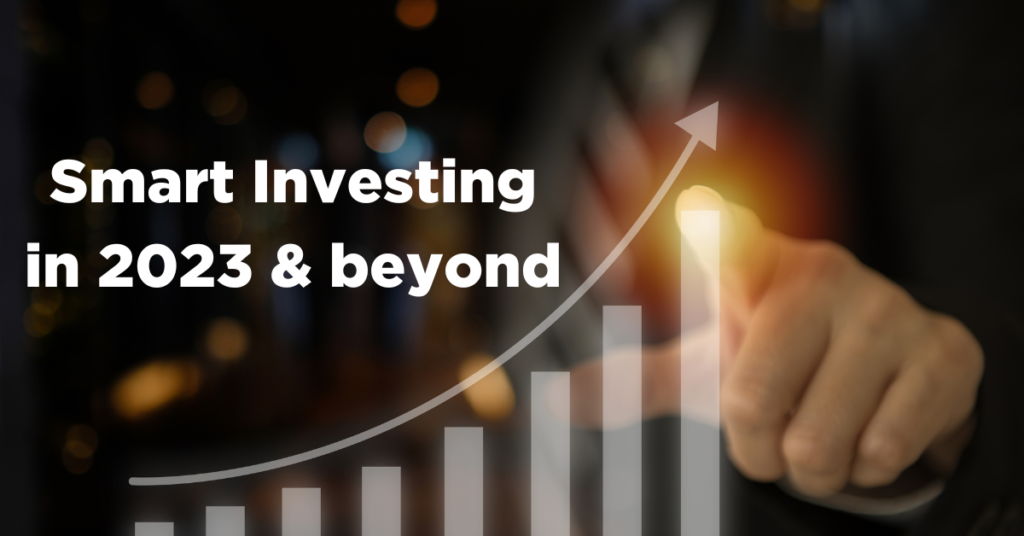I. Before you start
A. The importance of investing in the current economic landscape
In the dynamic economic environment of 2023, investing is crucial for building wealth, securing financial stability, and achieving long-term financial goals. Factors such as globalization, technological advancements, and political shifts have created a complex financial landscape with both opportunities and risks. By understanding and leveraging these changes, investors can capitalize on growth prospects and mitigate potential losses.
B. Understanding your personal financial goals and risk tolerance
Before diving into the world of investing, it is essential to identify your financial objectives and assess your risk tolerance. Financial goals can range from short-term needs, such as saving for a vacation, to long-term objectives like funding retirement or leaving a legacy. Risk tolerance is your ability and willingness to accept losses in pursuit of potential gains. Balancing your financial goals with your risk tolerance will help you make informed investment decisions and create a suitable investment strategy.

II. Building a Strong Financial Foundation
A. Developing a budget and emergency fund
Before investing, it is essential to establish a solid financial base. Start by creating a budget to track your income, expenses, and savings. This will help you understand your spending habits, identify areas for improvement, and allocate funds for investments. Additionally, set up an emergency fund with three to six months’ worth of living expenses to cover unforeseen events, such as job loss or medical emergencies. This fund acts as a financial safety net, reducing the need to dip into your investments during challenging times.
B. Reducing high-interest debt
Paying off high-interest debt, such as credit card balances or personal loans, should be a priority before investing. The interest rates on these debts often outweigh the potential returns from investments, making it more beneficial to eliminate them first. By tackling high-interest debt, you’ll improve your overall financial health and free up more funds to invest.
C. Understanding the role of taxes and inflation
Taxes and inflation can significantly impact your investment returns. Different investments may be subject to varying tax rates, which can affect your net gains. Familiarize yourself with tax implications and consider incorporating tax-efficient strategies in your investment plan. Additionally, inflation erodes the purchasing power of money over time. It’s essential to choose investments that can potentially outpace inflation to maintain your long-term financial goals.
III. Investment Principles and Strategies
A. Diversification and asset allocation
Diversification is the practice of spreading your investments across multiple asset classes (stocks, bonds, real estate, etc.) to minimize risk. By allocating your funds into different types of investments, you reduce the impact of a single underperforming asset on your overall portfolio. Asset allocation is the process of dividing your investments among various asset classes according to your risk tolerance, financial goals, and investment horizon. A well-diversified portfolio and strategic asset allocation can help minimize risk and optimize returns.
B. The power of compounding and long-term investing
Compounding is the process by which your investments’ returns generate earnings over time, which are then reinvested to generate even more earnings. The longer you hold your investments, the more significant the compounding effect. Long-term investing allows you to benefit from compounding, ultimately leading to exponential growth in your investment value.
C. Dollar-cost averaging and periodic rebalancing
Dollar-cost averaging (DCA) is a technique that involves consistently investing a fixed amount of money at regular intervals, regardless of market conditions. DCA reduces the risk of market timing by purchasing more shares when prices are low and fewer shares when prices are high. Periodic rebalancing ensures that your portfolio maintains its target asset allocation. By regularly reviewing and adjusting your investments, you can prevent your portfolio from becoming too heavily weighted in a single asset class, thus reducing risk.
D. Tax-efficient investing strategies
Tax-efficient investing aims to minimize the impact of taxes on your investment returns. Strategies include investing in tax-advantaged accounts (IRA, Roth IRA, 401k, etc.), holding investments with favorable tax treatments, and managing capital gains and losses effectively. By considering tax implications in your investment decisions, you can potentially enhance your after-tax returns.
IV. Traditional Investment Vehicles
A. Stocks and bonds
- Understanding stock and bond fundamentals: Stocks represent ownership shares in a company, providing investors with potential capital appreciation and dividends. Bonds are debt securities issued by corporations or governments, offering periodic interest payments and the return of principal upon maturity. Both asset classes have unique characteristics and risks, making them essential components of a well-diversified portfolio.
- Index funds and ETFs: Index funds and exchange-traded funds (ETFs) are passive investment vehicles that track a specific market index, such as the S&P 500. These funds offer investors a low-cost, diversified, and tax-efficient way to gain exposure to a broad market segment or a specific sector.
B. Mutual funds
- Active vs. passive management: Mutual funds pool investors’ money to buy a diverse range of securities. Active management involves a fund manager making decisions on security selection and trading to outperform a benchmark index. Passive management involves tracking a specific index to replicate its performance. Each approach has its benefits and drawbacks, such as cost, tax efficiency, and potential returns.
- Evaluating fund performance and fees: When selecting mutual funds, consider factors such as historical performance, expense ratios, management team, and investment style. While past performance is not indicative of future results, it can provide insight into the fund’s consistency and management’s ability to navigate different market conditions. Be mindful of fees, as high costs can significantly impact your returns over time.
C. Real estate
- Direct ownership vs. REITs: Real estate can be a valuable addition to your investment portfolio, providing diversification, income, and potential capital appreciation. Direct ownership involves purchasing and managing properties yourself, while real estate investment trusts (REITs) allow you to invest in a diversified portfolio of properties without direct ownership. Each option has its own set of risks, responsibilities, and potential returns.
- Commercial vs. residential properties: Commercial and residential properties have distinct characteristics, risks, and rewards. Residential properties typically offer more stable cash flows, while commercial properties can provide higher returns but may come with increased risk and management complexity. Understanding the differences between these property types can help you make informed real estate investment decisions.

V. Alternative Investments
A. Cryptocurrencies and digital assets
Cryptocurrencies, such as Bitcoin and Ethereum, have emerged as a new asset class offering potential diversification, high liquidity, and the possibility of significant returns. However, they are also characterized by high volatility and regulatory uncertainty. Investors should conduct thorough research and consider their risk tolerance before adding digital assets to their portfolios.
B. Peer-to-peer lending
Peer-to-peer (P2P) lending platforms connect borrowers with individual investors who provide loans in exchange for interest payments. This form of investing can offer higher interest rates compared to traditional fixed-income securities, but it also comes with credit and platform risks. P2P lending can be a suitable option for investors seeking income and diversification in their portfolios.
C. Crowdfunding and equity crowdfunding
Crowdfunding platforms allow individuals to invest in startups, small businesses, or specific projects by pooling funds from multiple investors. Equity crowdfunding offers investors an ownership stake in the business, while other forms of crowdfunding may provide rewards or interest payments. These investments carry higher risks due to the speculative nature of startups and lack of liquidity, but they also offer the potential for significant returns.
D. Commodities and precious metals
Investing in commodities, such as oil, gold, or agricultural products, can provide diversification and a hedge against inflation. Precious metals, in particular, have traditionally served as a store of value during economic uncertainty. Investors can gain exposure to commodities through futures contracts, ETFs, or direct ownership.
E. Art and collectibles
Art and collectibles, including fine art, wine, rare coins, and other collectible items, can offer portfolio diversification and potential long-term appreciation. However, these investments are often illiquid, require expert knowledge for valuation, and may be subject to high transaction costs. Investors should carefully weigh these factors before incorporating art or collectibles into their portfolios.
VI. Investing in Sustainable and Impactful Opportunities
A. ESG (Environmental, Social, and Governance) investing
ESG investing focuses on companies that demonstrate strong environmental, social, and governance practices. By investing in businesses that prioritize sustainability, ethical conduct, and good governance, investors can potentially achieve competitive returns while promoting positive societal change. ESG funds and ETFs are available to help investors integrate these considerations into their portfolios.
B. Green bonds and clean energy investments
Green bonds are fixed-income securities issued to finance environmentally friendly projects, such as renewable energy, pollution control, or sustainable agriculture. Investing in green bonds or clean energy stocks can provide portfolio diversification, potential returns, and the opportunity to support the transition to a sustainable economy.
C. Socially responsible mutual funds and ETFs
Socially responsible investing (SRI) funds and ETFs consider environmental, social, and governance factors in their security selection process, screening out companies that do not align with specific ethical guidelines. Investors can choose from a wide range of SRI funds, targeting different sectors, regions, or themes, to align their investments with their personal values.
VII. Retirement and Long-Term Planning
A. Understanding retirement accounts (IRA, Roth IRA, 401k, etc.)
Retirement accounts provide tax advantages to help individuals save for their post-work years. Traditional IRAs and 401ks allow for tax-deductible contributions and tax-deferred growth, while Roth IRAs and Roth 401ks offer tax-free growth and withdrawals. Understanding the various account types, contribution limits, and withdrawal rules is crucial for maximizing retirement savings and minimizing tax liabilities.
B. Annuities and pension plans
Annuities are contracts between an individual and an insurance company that provide a guaranteed income stream in exchange for a lump sum or periodic payments. Pension plans are employer-sponsored retirement plans that promise a specific benefit upon retirement. Both options can provide financial security and a steady income during retirement, but they may have limitations, fees, and tax implications to consider.
C. Estate planning and wealth transfer strategies
Estate planning involves arranging for the management and transfer of your assets upon your death or incapacitation. Key components include drafting a will, designating beneficiaries, establishing trusts, and minimizing estate taxes. Proper estate planning can ensure that your wealth is distributed according to your wishes and that your loved ones are financially protected.
VIII. Working with Financial Professionals
A. The role of financial advisors, brokers, and planners
Financial professionals can offer valuable guidance, expertise, and resources to help you achieve your investment goals. Financial advisors provide investment advice and portfolio management services, brokers facilitate the buying and selling of securities, and financial planners help create comprehensive financial plans addressing various aspects of your financial life. Each professional serves a different purpose, and you may choose to work with one or more depending on your needs.
B. Fee structures and fiduciary duty
Financial professionals may charge fees in various ways, including hourly rates, fixed fees, asset-based fees, or commissions. It’s essential to understand the fee structure before engaging any financial professional. Additionally, inquire about their fiduciary duty, which requires them to act in your best interest. Not all financial professionals have a fiduciary obligation, so it’s important to confirm this aspect when selecting a professional to work with.
C. Evaluating financial professional credentials and expertise
When choosing a financial professional, consider their qualifications, experience, and areas of expertise. Look for credentials such as CFP (Certified Financial Planner), CFA (Chartered Financial Analyst), or CPA (Certified Public Accountant) as indicators of their competence and commitment to ethical practices. Seek referrals from friends, family, or online reviews to find a reputable professional who aligns with your goals and values.
IX. Navigating Market Volatility and Economic Uncertainty
A. Recognizing market cycles and historical trends
Market cycles are characterized by periods of growth, followed by downturns, and eventual recoveries. Understanding market cycles can provide context for current conditions and help you make informed investment decisions. Studying historical trends can offer insights into how markets have behaved during past periods of volatility or uncertainty, enabling you to identify patterns and potential opportunities.
B. Strategies for managing emotions and avoiding common investing pitfalls
Emotions can significantly influence investment decisions, leading to potential mistakes such as panic selling, excessive trading, or overconfidence. Developing a disciplined, long-term investment strategy can help minimize the impact of emotions on your decision-making. Stay focused on your financial goals, maintain a well-diversified portfolio, and avoid reacting impulsively to short-term market fluctuations.
C. Protecting your investments with diversification and proper asset allocation
During periods of market volatility and economic uncertainty, it’s crucial to maintain a diversified portfolio and an appropriate asset allocation based on your risk tolerance, financial goals, and investment horizon. By spreading your investments across different asset classes and sectors, you can reduce the impact of market fluctuations and increase the resilience of your portfolio.
X. Conclusion
A. The importance of continual learning and staying informed
The investment landscape is constantly evolving, and staying informed is critical to making sound decisions. Continually educate yourself about new investment opportunities, market trends, and economic developments. Use various resources, such as financial news, investment blogs, books, and podcasts, to expand your knowledge and stay current.
B. Adapting to changes in the market and the economy
As market conditions and economic factors change, it’s essential to remain flexible and adaptable. Regularly review and adjust your investment strategy to ensure it remains aligned with your financial goals and risk tolerance. Be open to new ideas and investment opportunities while maintaining a disciplined approach.
C. Building and maintaining a resilient investment portfolio for long-term success
By combining the principles and strategies outlined in this guide, you can build a robust investment portfolio designed for long-term success. Stay focused on your financial goals, diversify your investments, manage risks, and continuously learn to navigate the ever-changing investment landscape with confidence.



